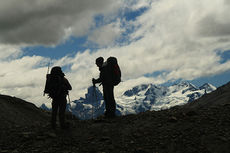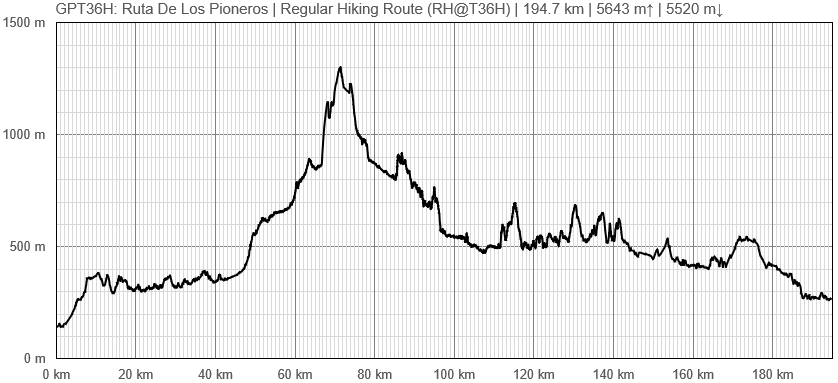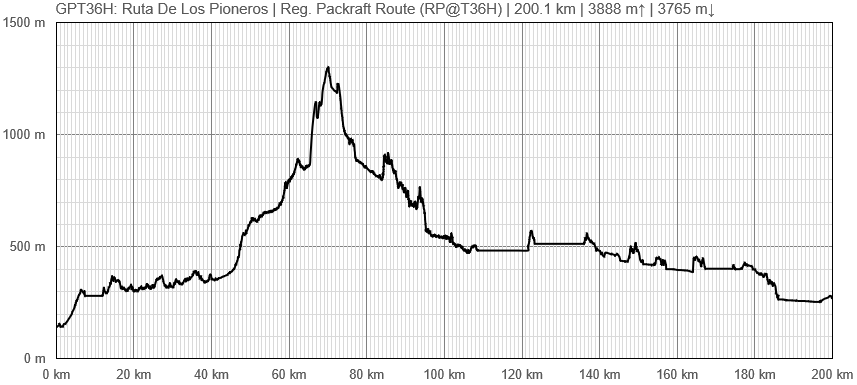GPT36H - Ruta De Los Pioneros
|
|
|
| |||||||||||||||||||||||||||||||||||||||||||||||||||||
Recent Alerts and Suggestions
Season Section Log
- GPT36H Regular Packrafting Route / Southern End: Laguna Clara to Villa O‘Higgins
2020-Jan-08 1.5 days Meylin Ubilla & Jan Dudeck
The „Ruta de los Pioneros“ is one of the historic routes that was created and used by the first settlers in the last century. This route connected Villa O’Higgins with Cochrane long before the Carreta Austral was completed in the year 2000.
The northern and the southern terminus; approx. 50 km on each end; are now upgraded to gravel roads. Only the roughly 100 km in the middle remain a classic animal trail made and created by people on horses to drive cattle.
To bypass as much as feasible of these gravel roads we have investigated in recent years multiple alternatives on both ends of GPT36H. Especially with a packraft most of these gravel road kilometers can be bypassed on a very attractive combination of lakes and rivers with shorter portages in between.
We now investigated and verified a route that first crosses the 2 km wide Lago Claro and than connects on an excellent 2 km trail to Rio Meyer. To continue either only cross Rio Meyer (like we did) or float downstream o. this river up to 4 km (alternative river exit to be scouted first!). An perfectly maintained trail leads then to Lago Biceño (2 to 6 km depending on only crossing Rio Meyer or floating downstream up to 4 km on Rio Mayer). Here a decision needs to be made depending on wind: either paddle a part of Lago Briceño or or continue walking 8 km to Salto on an scenic very well maintained trail (Alternatively a 6 km long trail connects from Lago Briceño to Lago Salto on a different route). After traversing 4 km on Lago Salto a 1 km short animal trail leads to Lago Cines. Once you reach Lago Cisnes it’s 13 km on a combination of lakes and rivers that gets you very close to Villa O’Higgins. Only the last 3 km into the village must be walked on a gravel road.
We travelled this route in 1.5 days and really enjoyed the landscape, the excellent trails and the scenic paddling. Even in suboptimal weather this route is feasible and offers plenty of alternatives and escape routes. Therefore I will re-route the regular packrafting route of GPT36H to this route.
Between Lago Claro and Lago Salto we discovered the best maintained trails of the entire Aysen region. Bridges cross even the smallest streams and all muddy areas are crossed on wooden passages. After years of hiking in this region this came as a surprise. But we also know why. These trails were not created to serve the public but a single family: los “Luksic”, the richest clan of Chile (https://en.m.wikipedia.org/wiki/Andrónico_Luksic_Abaroa). They buy up huge plots of land in this region to create family resorts and as investments. The land between Lago Claro and Lago Salto is owned to my knowledge by this family. And they have the money to contract a large stuff to i.e. create and maintain trails on their properties. What was nice: when a group of 3 employees passed us on a trail on quarts they did not challenge us but gave use useful recommendations how to continue. Legally, access to lakes, rivers and the coast must be given in Chile even if the private property i.e. surrounds a lake but landlords can make it difficult anyway. To my knowledge all access routes from public roads a locked but since we accessed this area on water we did not have to climb over locked gates. Therefore this route seams to me suitable for packrafters.
Multiple route variations are feasible that link in further lakes. Short bushwhacking portages might be required in this case but the landscape and vegetation seams generally more open than the Valdivian rain forrest on the Aysen coast. Someone can easily spend up to 5 days discovering other packrafting routes in this area.
- 2019-Nov-12 / Lea Geibel, Kevin Moe / 6 days / northbound / regular hiking route
This was a tough section for us! It rained and it rained and it rained and the trail turned to mud and was pretty overgrown in parts. We took the optional Hiking route after reaching Rio Bravo heading South to the Carretera Austral because we didn't feel comfortable forging on, knowing there was a high pass that was probably getting tons of snow instead of our rain, and a "dangerous river ford" that we were afraid would be tok dangerous with flooding too. The snow-line appeared to drop as low as 700 meters one night! We made surprisingly slow progress because of the conditions (entire trail flooded knee deep and extremely muddy after 6 days of rain) - were glad to have extra food with us. On the bail out route, about 10km from reaching the safety of the Carratera there was a pretty big river to cross. It was swollen after all the rain and scary and nearly floated us away. From the Carratera we hiked about 20 minutes before catching a lift back to Villa O'Higgins
11/12/2019 - les 2 As - regular hiking route Hi! We finished this day the section 36 from north to south. It took us 6 days without the last 37 kms on the road (we hitchhiked on this part). It was rough, we have had 2 days of bad weather (only rain at our altitude but it changes everything). You are isolated in the middle of nowhere and we met no one during 5 days. Officially no bush bashing but sometimes the path is barely invisible and unmaintained so hard to walk. From the 3rd day to the end, we have had many rivercrossings. Some were easy, some not and some also quite dangerous. With all the snow melting, the level of the river is very high and the current is strong (I do not recommand to try these fords without walking poles, these saved us). Same situation with the lakes we walked near. Their level is high and often the path was submerged and we had to walk litteraly in the lake (sometimes up to the waist). Luckily we met 2 cabañas (2 last nights) to dry our clothes and sleep under a roof. This made the section even more wonderful than it already was. A great experience!
Summary Table
| GPT36H: Ruta De Los Pioneros | Hiking | Packrafting | |||||
| Group | H: Aysen Sur | Total | 192.9 km | 55 h | 275.6 km | 76 h | |
| Region | Chile & (Argentina): Aysén (XI) | Trails (TL) | 83.8 km | 43.4% | 78.9 km | 28.6% | |
| Start | Cochrane | Minor Roads (MR) | 69.2 km | 35.9% | 44.0 km | 16.0% | |
| Finish | Villa O'Higgins | Primary Roads (PR) | 34.6 km | 18.0% | 7.3 km | 2.7% | |
| Status | Published & Verified | Cross-Country (CC) | 5.3 km | 2.8% | 7.7 km | 2.8% | |
| Traversable | Dec - Mar (Maybe: Nov, Apr) | Bush-Bashing (BB) | - | - | - | - | |
| Packraft | Very Useful | Ferry (FY) | - | - | - | - | |
| Connects to | GPT35, GPT36P, GPT37H, GPT37P | Investigation (I) | (10.2 km) | (5.3%) | (1.8 km) | (0.7%) | |
| Options | 1157 km (16 Options & Variants) | Exploration (EXP) | - | - | - | - | |
| Hiking | Packrafting | Total on Water | 137.7 km | 49.9% | |||
| Attraction | 4 (of 5) | 5 (of 5) | River (RI) | 45.5 km | 16.5% | ||
| Difficulty | 5 (of 5) | 5 (of 5) | Lake (LK) | 92.2 km | 33.4% | ||
| Direction | Both ↓↑ | Both ↓↑ | Fjord (FJ) | - | - | ||
| Comment | Packrafting: ↓ More lake packrafting, ↑ More river packrafting | ||||||
| Character | Valdivian Rain Forest, Alpine Terrain, Farmland, Settlers, Unpeopled Areas, River Packrafting, Lake Packrafting, Road Walking | ||||||
| Challenges | Demanding River Fords, Exposure to Elements, Bush Bashing, Demanding Navigation, Resupply Distance | ||||||
Satellite Image Map
Elevation Profile
Elevation Profile of Regular Hiking Route
Elevation Profile of Regular Packrafting Route
Section Planning Status
Recommended Travel Period
Benefits of Hiking and Packrafting
Recommended Travel Direction
Section Length and Travel Duration
Suitable Section Combinations
Section Attractiveness
Section Difficulty
Resupply
Resupply Town
Town: Villa O’Higgins
The biggest thing to realize about Villa O’Higgins is that nearly all of the lodging and restaurant options only take cash and there is no ATM in town. The closest place to withdraw money is Cochrane which is a 9-hour drive. Fortunately, there are two grocery stores in town thatl take credit cards. Lodging options vary from camping to a bed in a hostel.
Shopping: Food
Shopping: Fuel
Shopping: Equipment
Services: Restaurants
Services: Laundry
Services: ATM and Money Exchange
Accommodation: Hostals and Hotels
Accommodation: Cabañas
Accommodation: Camping
Transport: Ground Transport
Transport: Ferries
Transport: Shipping Services
Resupply on the Trail
Location, Names, Available Items and Services
Access to Route and Return
Access to Start
Return from Finish
Escape Options
Permits, Entry Fees and Right-of-Way Issues
Regular Route
Regular Hiking Route
- Route description by Kara Davis after Season 2017/18:
Walk through town and join Highway 7, a moderately trafficked dirt road. The Regular Hiking Route follows X-901, a beautiful but fenced dirt road that culminates in the view of a stunning glacier, for about 28 km until it ends at a blockade just after the Mirador Calluqueo. Along X-901 there are few residences but extensive fence line on both sides. At the end of the road, the route transitions into a braided single track trail that may be confusing to follow.
Comment by Jan Dudeck: I recently changed the regular packrafting route of GPT36H. This change avoids 35 km of gravel and adds around 70 km of paddling on the two lakes and one river. It’s a big detour but adds impressive beauty. Note that paddling Lago Cochrane is very challenging as wind can be firce. Follow the regular packrafting route only if you are willing and prepared to possibly wait several days on the shore of Lago Cochrane if wind makes paddling this lake unsafe.
The trail, called La Ruta de Los Pioneros since it is frequently used by the local people, occasionally passes run down refugios as it winds through the forest. At the beginning of the climb to the highest pass, the trail joins a glacial river. Eventually the trail leaves the river to the west and follows a higher route above the valley that is occasionally marked by stone cairns. The top of the pass is at approximate elevation 1.300 m. From this point, there are several kilometers of very exposed hiking among rolling hills.
The track descends down to treeline at a small, unnamed lake which is the source of the Río Bravo. Join the river and cross it as necessary. There are some stone cairns that mark the way, but they can be hard to spot. When the route is unclear, just follow the river bed. Where the trail deviates from the river bed to the east, it becomes easier to follow. The trail soon climbs about 80 m and remains above Río Bravo. Here there is the occasional small area to camp. To reach Lago Alegre, the trail leaves Río Bravo and travels through an open forest.
Packrafters put in for Lago Alegre at a red sand beach. In general, both banks are very steep and heavily vegetated, but there are some flat areas near the shore where it may be possible to camp. Take-out is located at a rocky beach on the southeast end. 100 m from the Lago Alegre shoreline is an intact refugio; if you look closely inside, you may spot the etchings of GPT trail blazers, Jan and Meylin.
From the refugio, there is a well-formed track to Lago Christie. The Regular Hiking route around the east side of Lago Christie is generally easy to follow, but be aware of the occasional spurs that leads away from the main route. The track climbs and descends frequently as it makes its way around the lake and offers a beautiful view of several glaciers. Watch for the occasional stone cairn or red spray-painted arrow to indicate the way. Camping is possible in the forest.
The route exits onto X-911, a well formed and lightly trafficked gravel road. X-911 ends at X-905, and hikers continue to follow this road for around 20 km towards VIlla O’Higgins. X-905 is fence lined most of the way with the occasional residence.
Río Mayer is a big, no-nonsense river that is swift at higher flows. It does however mellow out where the GPS route indicates packrafters should put in (a small beach on the other side of the fence).
The Regular Hiking Route follows the Carretera Austral into Villa O’Higgins.








